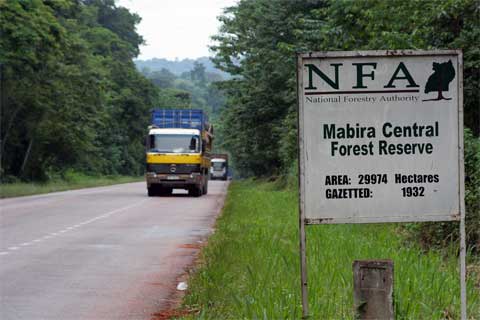A few days ago, I almost broke down while traveling to Eastern Uganda as I witnessed the devastating transformation of the once-mighty Mabira Forest.
Just a few years ago, travelers passing through Mabira Forest would be struck by its cool climate and fresh air. During the day, the dense canopy provided a stunning shade, while the diverse bird species filled the air with charming melodies.
However, today, the scene is plainly different. The forest has been severely degraded, with trees remaining only along the road. I couldn’t help but wonder, who are those people plundering this forest? What kind of food do they eat? Are our legislators aware of this? If yes, what is being done to arrest the situation?
The history of forest demarcation in Uganda dates back to the colonial era. In 1895, the British colonial government established the Forest Department to manage and conserve Uganda’s forests. The Forest Ordinance was enacted in 1929, providing a legal framework for forest management.
By 1938, the colonial government had gazette 15 Central Forest Reserves, covering approximately 1.2 million hectares. After gaining independence in 1964, the Forest Department became responsible for managing the country’s forests.
Post-independence forest policy developments have included the establishment of the National Forestry Service in 1970, the formulation of the National Forestry Policy in 1988, the enactment of the Forestry Act in 1995, and the revision of the National Forestry Policy in 2001.
Uganda’s demarcated forests include Mabira Forest Reserve (30,000 ha) in Buikwe and Jinja districts, Budongo Forest Reserve (82,000 ha) in Masindi and Buliisa districts, Bwindi Impenetrable National Park (32,092 ha) in Kanungu, Kisoro, and Rubanda districts, Mgahinga Gorilla National Park (3,437 ha) in Kisoro district, Kibale National Park (79,500 ha) in Kamwenge,Kibaale, and Kyenjojo districts, Rwenzori Mountains National Park (99,500 ha) in Bundibugyo, Kasese, and Ntoroko districts, Mount Elgon National Park (11,120 ha) in Mbale and Kapchorwa districts, Kalinzu Forest Reserve (15,000 ha) in Bushenyi and Rubirizi districts, Tooro-Semliki Wildlife Reserve (54,000 ha) in Kabarole and Ntoroko districts, and Bugoma Forest Reserve (41,000 ha) in Hoima and Kibaale districts.
Despite these efforts, deforestation continues to eat up Ugandan forests. The causes of this are in fact many-sided. These include; agricultural expansion, urbanization, charcoal and timber production, population growth, and lack of enforcement and many others. These factors have devastating consequences, including loss of biodiversity, climate change, soil erosion, water scarcity, and economic impacts.
The Ministry of Water and Environment, particularly the forestry department, bears significant responsibility for Uganda’s alarming deforestation. Their ineffectiveness and lack of proactive measures have emboldened encroachers to ravage the country’s forests with impunity. It is appalling that individuals can boldly clear forests in broad daylight, without fear of consequences, due to the Ministry’s clear inaction.
Furthermore, why can’t the Ministry enforce the reinstatement of the boundaries? What is difficult about restoring the original forest boundaries and protecting the remaining forests? This lack of action raises serious questions about the Ministry’s commitment to conservation. Moreover, planting forests on hills would prevent landslides and soil erosion, protecting the livelihoods of local communities. It’s crucial that our legislators prioritize a forestation even on all Ugandan hills, promoting sustainable land use and eco-tourism.
Unfortunately, most authorities in Uganda have a bad habit of demeaning people’s advice. The Banyankole call this “omugayano”. This dismissive attitude disregards the fact that authorities are public servants, accountable to the people.
Instead of listening to constructive criticism, they often belittle advisors, asking who they are, where they come from, and what they will do if their advice is ignored. This omugayano habit is detrimental to our nation’s progress, as authorities only act when someone speaks out boldly, often using radical language like go and eat your mother’s something-something. They can’t understand that can not understand that the public would appreciate to see such a crucial issue handled with all urgency it deserves. No!
Over to them now, I would appreciate seeing tangible evidence of the Ministry’s commitment to conservation, including arrests and successful prosecutions of encroachers, large-scale reforestation efforts, and collaborative initiatives with local communities, law enforcement agencies, and conservation organizations.
Specifically, I would like the Ministry to publicly account for their efforts by publishing quarterly reports on deforestation cases, arrests, and prosecutions, and providing regular updates on reforestation progress and community engagement. Establishing a national task force to combat deforestation and forest degradation would also demonstrate a genuine commitment to conservation.
The writer is CEO, Pamoja Communal Empowerment Network, Email: [email protected]
If you would like your article/opinion to be published on Uganda’s most authoritative news platform, send your submission on: [email protected]. You can also follow DailyExpress on WhatsApp and on Twitter (X) for realtime updates.



